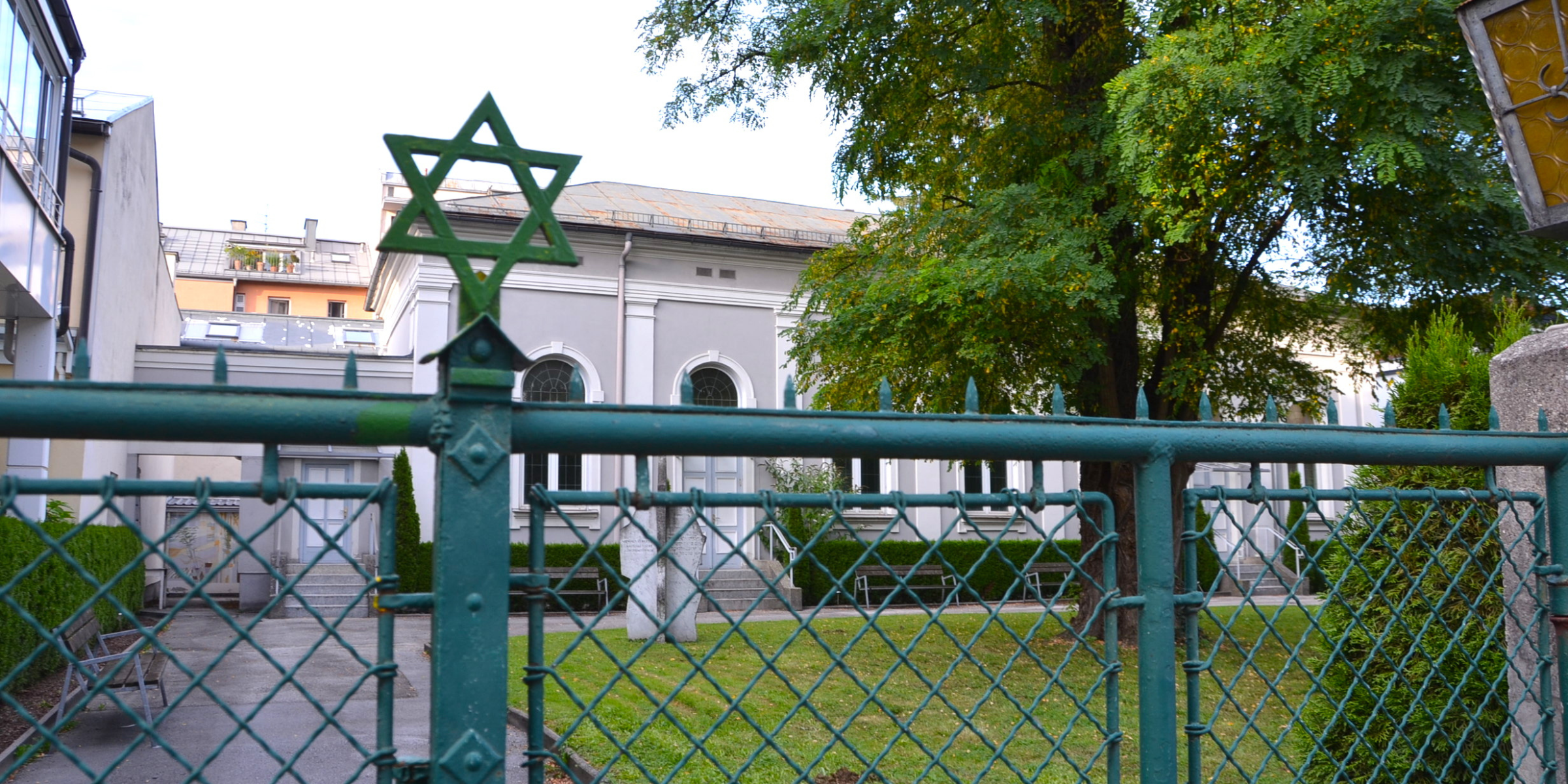The Jewish Traveler
Summertime in Graz and Salzburg

As my daughter—who’s seen the film 41 times—will tell you, there are myriad reasons to love The Sound of Music. She would highlight a dashing young Christopher Plummer; Julie Andrews’ ringing bell of a soprano; a score by the iconic Jewish musical team of Rogers & Hammerstein; and the seven adorable von Trapp kids do-re-mi-ing their way through alpine landscapes.
For me, as an adult, the top reason is the film’s portrayal of resolutely anti-Nazi Austrians. Ripping up the swastika flag and thumbing his nose at Nazi orders, Captain von Trapp runs counter to the common image of Austria as not only the birthplace of Adolf Hitler and many of his henchmen but also as a land where antisemitism lies barely dormant beneath a veneer of gemütlichkeit (the Austrian and German term for warm feelings).
So it was with a mix of curiosity and Hollywood nostalgia that I visited Austria last summer, bound first for Graz and then Salzburg—the country’s second- and fourth-largest cities, respectively. I was soon rewarded with some of the elegant sights I’d fantasized about while watching the von Trapps entertain at their lakeside palazzo on the outskirts of Salzburg.
Set amid the foothills of the Eastern Alps, Graz straddles the Mur River and is the heart of a southern Austrian region called Styria. It was the medieval seat of Hapsburg royalty and the birthplace of both Arnold Schwarzenegger and Archduke Franz Ferdinand, the Austro-Hungarian heir whose assassination in 1914 in Sarajevo touched off the First World War—and the eventual collapse of his family’s empire.
Graz boasts one of Central Europe’s best-preserved historic centers. Walking along Herrengasse, the pedestrianized commercial thoroughfare, I stopped every couple of minutes to take pictures of the magnificent facades. Medieval and baroque, in pistachio, peach and butter-yellow, some are adorned with intricate ornamentation and others dotted with sculptures set into arched nooks.
From Graz, Salzburg is a three-hour drive or a four-hour train ride northwest through staggeringly beautiful Alpine landscapes. The city’s name is derived from the German word for salt, the mineral that has been mined in the region for thousands of years. Beginning in the seventh century, Salzburg was ruled by a succession of religious leaders—archbishops and prince-archbishops who became political heavyweights.

The Salzach River splits the city in half; its eastern bank leads to New Town (Neustadt), and its western side gives way to the remarkably preserved Old Town (Altstadt) with its celebrated Getreidegasse pedestrian street, a cobblestoned alley best known for its elaborate hanging signs. Shopkeepers for centuries have advertised their wares with fanciful swinging iron signs that depict their specialty—from makers of traditional lederhosen to McDonald’s.
Both Graz and Salzburg trace a Jewish presence back to the 12th century, when communities flourished before being harassed, tortured and then violently expelled in the late 1400s. It was another 400 years before Jews were allowed to resettle in these areas, yet when they did, they quickly became prominent in each city’s economic and intellectual life. One example is Theodor Herzl, the Austro-Hungarian father of Zionism, who spent some of his most productive years in Salzburg.
All that came to a violent end with the rise of Nazism in the 1930s. The Holocaust decimated southern Austria’s Jewish communities. The Jewish population of Graz and the rest of the Styria region stood at around 2,000 before Kristallnacht in November 1938; it is 150 today. Salzburg’s Jewish community, which was never large, numbered almost 250 in 1938. One hundred Jews now live in the city.
Less than a century later, Graz has an almost uncannily peaceful feeling—lively yet uncrowded, compact enough to cover on foot, abundant in both outdoor cafes and shady green spaces. Walking along its streets, retirees, local university students and scout troops are among those who appear to be relaxing in the sunshine. And in smaller, considerably more expensive and far more touristy Salzburg, fans of both native son Wolfgang Amadeus Mozart and The Sound of Music flock to a number of related sights.

These cities have witnessed tragic Jewish history, and Austria’s post-Holocaust Jewish communities, despite official support, are pale shadows of their prewar selves. But after the Hamas terror attacks in Israel, I was gratified to vacation in southern Austria without seeing any of the anti-Israel graffiti and pro-Palestinian protests that are ubiquitous in much of Europe.
Despite a persistent strain of Nazi sentiment among some elements of the Austrian political class—exemplified by this year’s triumph in national elections of the far-right Freedom Party, founded by onetime Nazis—anti-Israel and anti-Jewish expression, including Holocaust denial, are restricted both by law and social taboo, as they are in Germany.
What I saw instead, as I strolled across a pedestrian bridge in Salzburg, were plaques every 20 feet or so highlighting key figures from Salzburg’s Jewish and Holocaust history.
I later learned that I had been crossing the Marko Feingold Bridge, which connects the street where Mozart once lived to Salzburg’s Old Town and is named in tribute to the longtime leader of Salzburg’s postwar Jewish community. Feingold, a survivor of four concentration camps who died in 2019 at the age of 106, led the rebirth of Jewish life in the city and the rebuilding of the Salzburg Synagogue, a 1901 landmark that was reconstructed in the 1960s.
In Graz, meanwhile, I was surprised at the prominent location of the soaring red-brick New Synagogue of Graz, whose glass dome towers over the Mur River. This house of worship was also rebuilt on the site of its predecessor—an 1895 edifice destroyed on Kristallnacht—and reopened in 2000.
In both square footage and prominence, these buildings are outsized in comparison to the winnowed communities they serve. But like Austria itself—reborn as a liberal democracy after an oftentimes turbulent and tragic 20th century—these Jewish communities are reminders of how optimism can triumph.

Graz
Just off an alley from Herrengasse, the main pedestrian route in the historic center, is the entrance to Schlossberg, a hilltop fortress that is Graz’s main attraction. Getting there is half the fun: Choose from a funicular, a glass elevator or the many terraced steps that ascend 1,500 feet to a mountaintop aerie with gardens, cafes and spectacular views.
With its Modernist blocky design of glass dome and red bricks—some sourced from the ruins of its predecessor—the New Synagogue of Graz is easy to spot along the riverfront at David-Herzog-Place, named in memory of the city’s immediate prewar rabbi. Its interior is no less striking, with a minimalist white design and plain metal ark that pointedly contrast with the ornamentation of prewar temples. The Orthodox congregation serves the Jewish population of the entire Styria region and is home to The House of Names Holocaust and Tolerance Centre Styria, an exhibition and education space devoted to the Shoah.

Murinsel, a translucent floating island set in the middle of the Mur River, is spectacularly lit by night. It was built when Graz was named the European Capital of Culture for 2003, as was the nearby Kunsthaus Graz, a contemporary art museum whose exhibits are less memorable than its black, undulating exterior (locals call it the “Friendly Alien”).
Salzburg
From nearly every vantage point, the circa-1077 Hohensalzburg—one of Europe’s largest castles—is visible on a hill above the city. For centuries, it sheltered generations of Salzburg rulers. Today, the fortress is a hive of tourist activity, with multiple museums and an impressive collection of medieval weaponry.
Salzburg is filled with live classical music, especially in summer, when the Salzburg Festival draws global stars for five weeks of performances. Although I visited after the festival, I was able to find last-minute tickets for a Mozart concert at the Mirabell Palace, a riverfront palazzo in the New Town with lovely gardens.
Salzburg’s historic center is centered around Getreidegasse and its zone of elegant, shop-filled alleys and graceful plazas. Heading east on Getreidegasse, keep your eyes trained on street signs to spy when the name changes to Judengasse (Jews’ Alley). This area was the site of the medieval Jewish community.

The Salzburg Synagogue is set back unobtrusively from the street at Lasserstrasse 8, behind a metal gate featuring Stars of David. A small plaque on the street outside memorializes Jews murdered in the Shoah.
While technically nondenominational, the synagogue follows Orthodox rites. Thoughtfully reconstructed with a dove-gray facade and gracefully ornate chandeliers in its otherwise spare sanctuary, the temple nods to history with vintage menorahs around the bimah and a collection of prewar Torahs. There is also a Kristallnacht memorial sculpture in the courtyard. To see any of it, you’ll need to make advance arrangements; guided tours require a five-person minimum.
The Mozart Geburtshaus, a prominent daffodil-yellow house in the Old Town at Getreidegasse 9, is the composer’s birthplace and the town’s top attraction. Filled with Mozart’s keyboards, furniture and family portraits, it’s a must-see for lovers of the classical genius. Unfortunately, its vintage stairs make it inaccessible to some.
But the Mozart Wohnhaus, a five-minute stroll across the river, was renovated following wartime destruction and is fully accessible. Music fans will enjoy this peek into the residence where Mozart composed some of his popular piano concertos.
Salzburg’s most popular music might well be the soundtrack you can sing along to during the Original Sound of Music Tour. The four-hour round-trip bus expedition from central Salzburg remains the most popular of Salzburg’s numerous offerings related to the movie.
Hilary Danailova writes about travel, culture, politics and lifestyle.










 Facebook
Facebook Instagram
Instagram Twitter
Twitter
Leave a Reply